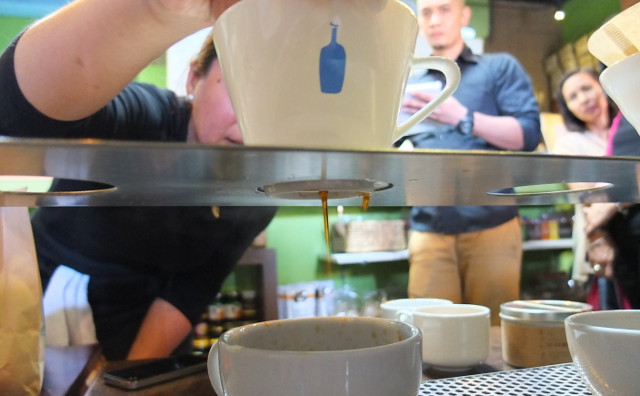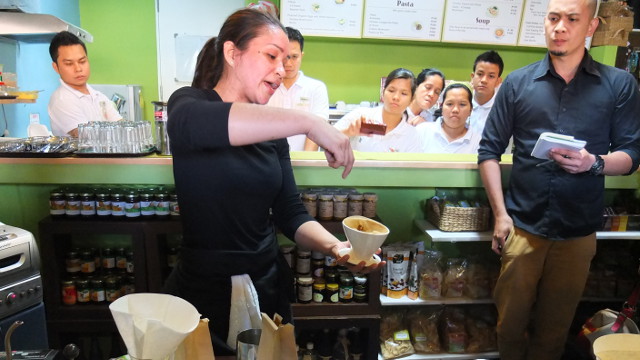SUMMARY
This is AI generated summarization, which may have errors. For context, always refer to the full article.

MANILA, Philippines – Master barista Selina Viguera returned to the Philippines with a mission: to educate Filipinos about coffee.
This is not to say that we don’t know much about it. After all, the Philippines was once the 3rd biggest producer of coffee beans.
But new ways of brewing coffee have been brewing in different parts of the world. In San Francisco, where Selina is head barista at Blue Bottle Coffee, the coffee scene is particularly hot.
Last January 15 at ECHOcafe in Serendra, Selina demonstrated a novel way of coming up with your coffee cup: simply, let your coffee drip.
Hand drip coffee is a refreshing alternative to more popular methods which involve wallet-busting coffee-makers and machines.
The basic implements for the hand drip method are a pot with a swan neck in which to boil water, a coffee-grinder, coffee filter, and a ceramic coffee dripper (avoid plastic ones because they affect the coffee taste).
Drip by drip
1. After boiling water and grinding your coffee beans (Selina recommends medium to light roast as they preserve the taste of the coffee — dark roast focuses on the smoky taste), place the ceramic coffee dripper on top of your mug.
2. Place a filter inside the coffee dripper; open it up so that it presses against the walls of the coffee dripper. Selena recommends bamboo paper filters to avoid getting “paper” taste into your coffee. There are permanent filters made of perforated metal or plastic mesh for those who want to reduce their waste.
3. With your swan-necked pot, pour hot water slowly onto the sides of the filter so they press onto the wall of the coffee dripper more. Don’t worry about the water that consequently ends up in the mug.
4. Next, you put your desired amount of ground coffee in the filter. Retrieve your pot and slowly pour water onto the layer of coffee in small circles. This creates a foamy top layer called the “bloom” which is a chemical process releasing air trapped in the coffee.
5. Coffee will start to drip into your mug. This is called the first drip. After this, leave the coffee for around 30 seconds until the bloom dissipates.
6. The bloom will disappear leaving a fairly even-levelled layer of coffee. Again, very slowly pour water in small circles starting from the middle of the coffee.
7. Let the water seep into the coffee and repeat. Brewed coffee should start steadily dripping into your mug. Wait until it drips no more or until your mug is full.
Voila, hand drip coffee!
For more detailed instructions, you can watch this video posted by YouTube user bltafel:
Brew-nefits
For Selina, contemplating on the benefits of hand drip coffee is as pleasurable as savoring the coffee itself.
According to her, this method teaches coffee-drinkers “the value of fresh, made-to-order coffee. In machines, the coffee is getting rancid. With hand drip, you’re more assured of freshness.”
Freshness is a big deal for Selina.
The Pinay barista laments that in the Philippines, it’s common practice to pre-ground coffee and leave it in the cupboard for days and days before actually brewing it.
She advises coffee-drinkers in search of great-tasting brews to ground their coffee beans only right before they make coffee. This preserves the taste and keeps in the fresh scents and chemicals released by coffee beans when they are newly-ground.
Another perk of hand drip coffee is that it makes less waste.
Selina enthuses, “Walang sayang (nothing is wasted). You use just what you need for one cup.”
But beyond the practicality of it is the philosophy behind it. For her, the use of automatic coffee machines makes “you feel disconnected to your coffee.”
The magic of hand drip is that you see everything happening under your nose. Every process, every step is facilitated by you and revealed to you. This old school way takes your coffee out of the mysterious churnings of a complicated machine and into a simple cup that uses the power of gravity.
Like wine
Selina’s love for coffee has reached the level of connoisseurship.
“Coffee is like wine,” she says with a sparkle in her eyes.
Being a barista for 7 years and a coffee-lover for longer, Selina has traced the various waves of the coffee industry and the popularization of coffee.
She explains that the first wave of coffee was the boom in demand for instant coffee. Coffee drinkers valued the speed and convenience of this new quick brew. Coffee was not fresh but at least it was cheap.
In rolled the second wave bringing the now ubiquitous coffee chains with their pricey frappes and designer coffee. Now, people are willing to shell out P150 for a cup of coffee.
The Philippines is largely still in the second stage while other countries like the US are already enjoying the 3rd stage: the geekification of coffee.
In this new coffee age, coffee-making has become as scientific as the search for the Higgs boson particle. Baristas use ultra-precise scales and timers to measure water, ground coffee and milk. For 3rd wave coffee lovers, every minute detail and process makes a difference to their coffee.
Selina looks forward to the possibility of staying in the Philippines for good and helping develop the coffee industry. She hopes to help not only coffee drinkers get better tasting coffee but also coffee bean harvesters and farmers who support their families with this miracle bean.
Filipinos are looking forward to that day as well. – Rappler.com
Add a comment
How does this make you feel?



There are no comments yet. Add your comment to start the conversation.